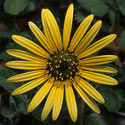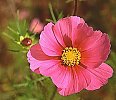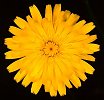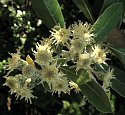|
Family: Asteraceae / Compositae (daisy family)
Life
> eukaryotes >
Archaeoplastida >
Chloroplastida
>
Charophyta > Streptophytina > Plantae (land plants)
> Tracheophyta (vascular plants) > Euphyllophyta > Lignophyta (woody plants)
> Spermatophyta (seed plants) > Angiospermae (flowering
plants)
> Eudicotyledons > Order: Asterales
There are 1528 genera and 22750 species worldwide
(cosmopolitan), of which 201 genera and 2269 species are native to southern
Africa. Another 59 genera and 157 species have become naturalised in the region,
and 42 genera and 139 species are cultivated.
Tribes in the Asteraceae that occur in southern Africa
Based on Herman et al. (2000).
|
Arctoteae
Fifteen genera and 203 species are native to southern Africa.
|

|
|
Anthemideae
Twenty-eight genera and 298 species are native to southern Africa,
with six genera and 10 species naturalised and nine genera and 37 species cultivated. |

|
|
Astereae
Twenty genera and 273 species are native to southern Africa,
two genera and seven species naturalised and 10 genera and 20
species cultivated.
|

|
|
Calenduleae
Seven genera and 88 species are native to
southern Africa, with one genus and species naturalised, and an
additional two species cultivated. |

|
|
Coreopsideae
Three species are cultivated southern Africa. |
|
|
Cynareae
Six genera and 30 species have become naturalised in
southern Africa, with an additional seven genera and 17 species cultivated. |
|
|
Eremothamneae
Two genera and three species are native to southern Africa. |
|
|
Eupatorieae
Three genera and eight species are native to
southern Africa, with five genera and 10 species naturalised and an
additional three genera and six species cultivated. |
|
|
Gnaphalieae
Fifty-six genera and 561 species are native to
southern Africa, with two genera and eight species naturalised and
one genus and two species cultivated. |
 |
|
Helenieae
One genus and two species are native to southern
Africa, with an additional four genera and nine species naturalised
and another genus and species cultivated. |
 |
|
Heliantheae
Seven genera and fourteen species are native to southern
Africa, with nineteen genera and 41 species naturalised and an
additional five genera and 22 species cultivated. |
 |
|
Inuleae
Eleven genera and 54 species are native to southern
Africa, with two genera and two species naturalised.
|
|
|
Lactuceae
Four genera and 17 species are native to southern
Africa, with 10 genera and 36 species naturalised and four genera
and nine species
cultivated in the region. |

|
|
Mutisieae
Seven genera and 51 species are native to southern
Africa. |
|
|
Plucheeae
Eight genera and 25 species are native to southern
Africa. |
|
|
Senecioneae
Twenty genera and 571 species are native to southern
Africa, one species is naturalised and an additional 16 species are
cultivated in the region.
|

|
|
Stiffteae
One species cultivated in southern Africa - Stifftia
chrysantha (native to Brazil). |
|
|
Tarchonantheae
Two genera and 15 species are native to southern
Africa.
|
 |
|
Vernonieae
Nine genera and 77 species are native to southern Africa, two genera and two species
are naturalised and an additional genus and two species are cultivated in
the region. |
|
| Not assigned to tribe: Corymbium. |

|
|
Not assigned to tribe: Cypselodontia. |
|
Species that provide food and cullinary herbs
Anthemis nobilis (Chamomile) |
|
Arctium
lappa (Burdock, Gobo)
Native to Europe and introduced to Asia
and North America. The roots are used medicinally for skin complaints,
rheumatism and as a diuretic. Young roots are eaten as a vegetable.
Cultivated mainly in Japan. Has been cultivated in southern Africa, but not
well known here. |
|
Artemisia dracunculus (Tarragon) |
|
Cichorium (Endive,
Chicory) |
|
Cynara
cardunculus (Cardoon) The
fleshy leaf bases are eaten as a vegetable and the dried flowers are used
for curdling milk. Originates from southern Europe and Northwest Africa. |
|
Cynara
scolymus (Globe artichoke) Originates from North Africa. The flowerhead can be pickled, baked, fried, boiled or
stuffed. Young artichokes can be eaten raw. |
|
Helianthus annuus (Sunflower)
Sunflowers originate from North America and are now
grown extensively for their seeds which produce vegetable oil that is used in
cooking, salad oils and margarines. The residue after oil extraction provides a
high protein food source for livestock. |
|
|
Helianthus tuberosus (Jerusalem Artichoke) The tuber is eaten cooked in casseroles and sauces or
eaten raw in salads. Originates from North America. Introduced to Europe in the 17th century. |
|
|
Lactuca sativa (Lettuce) Lettuce originates from the wild Lactuca serriola
found in the Mediterranean and Near East and has been transformed from an erect
plant with bitter leaves to various cultivars including ones with distinctive
heads of chlorophyll deficient leaves. |
|
Publications
-
Bremer, K. 1994. Asteraceae, Cladistics
& Classification. Timber Press, Portland, Oregon.
-
Herman, P.P.J., Retief, E., Koekemoer, M.
& Welman, W.G. 2000. Asteraceae (Compositae). In: Seed Plants of
Southern Africa (ed. O.A. Leistner). Strelitzia 10: 101-170.
National Botanical Institute, Pretoria.
-
Hilliard, O.M. 1977. Compositae in Natal.
University of Natal Press, Pietermaritzburg.
- Hilliard, O.M. 1978. The geographical distribution of
Compositae native to Natal. Notes from the Royal
Botanic Garden Edinburgh 36: 407–425.
- Koekemoer, M. 1996. An overview of the Asteraceae in
southern Africa. In: D.J.N. Hind & H.J. Beentje (eds), Compositae: Systematics. Proceedings of the
International Compositae Conference, Vol. 1: 95–110.
Royal Botanic Gardens, Kew.
-
Levyns, M.R. 1950. Compositae. In: Flora of
the Cape Peninsula (eds R.S. Adamson & T.M. Salter). Juta & Co.,
Ltd., Cape Town, pp. -.
-
Merxmüller, H. 1967. Asteraceae. Prodromus
einer Flora von Südwestafrika 139: 1-185.
-
Pope, G.V. 1992. 97. Compositae. Flora
zambesiaca 6,1: 1-264.
- Stirton, C.H. 1983. Nocturnal petal movements in the
Asteraceae. Bothalia 14: 1003–1006.
- Vincent, P.L.D. & Wilson, S.L. 1997. The systematic
value of the surface micromorphology and anatomy of
cypselae of some members of the Senecioneae, Liabeae
and Vernonieae (Asteraceae). South African Journal of
Botany 63: 382–399.
|
